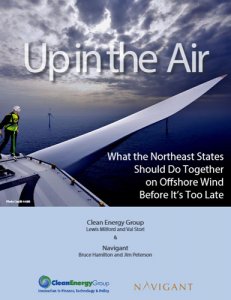The disappointing news that the Cape Wind project might never be built highlights a stark conclusion: U.S. offshore wind policy isn’t working. This is according to a new report by Clean Energy Group and Navigant Consulting, Inc. in the first policy assessment after the major setback of the nation’s first proposed offshore wind project.
In Up in the Air: What the Northeast States Should Do Together on Offshore Wind, Before It’s Too Late, CEG and Navigant describe how the Cape Wind project struggled amidst a decade of fierce local opposition. But the report says the project’s difficulties highlight a larger policy problem—it is almost impossible for a single state to jumpstart the entire U.S. offshore wind industry. The report recommends a multi-state collaboration among states to create stronger and consistent regional policies, financing actions, and permitting across the Northeast states.
“Cape Wind was a battle of the wallets, and the fossil fuel wallet evidently won,” said Lewis Milford, President of Clean Energy Group and the lead author of the report. “But there is a larger and more important story behind this controversy. If Northeast states want to reduce the costs of these projects and create offshore wind jobs, they must develop clear and consistent policies across the region, to give developers good reason to build projects here. If they don’t act together soon, they will lose this clean energy resource for decades to come, which will be bad for the economy and the environment.”
“If it is the ultimate goal of any East Coast state to develop major offshore wind projects, it is imperative that those states work together to develop mechanisms to overcome the major barriers associated with such projects, specifically, high capital costs, lack of infrastructure (e.g., transmission, ports) and regulatory issues,” says Bruce Hamilton, director with Navigant’s Global Energy Practice.
This paper recommends the states consider seven multi-state policy areas for regional action.
- Regional Offshore Wind Target. The establishment of a practical regional target (or target range) for offshore wind capacity would produce meaningful economic development and environmental benefits by creating a clear demand signal to developers.
- Coordinated Policy Incentives. Individual state policy drivers, including any incentives for developers, should be consistent across the region to drive demand and produce cost reductions over time through scale up of the offshore wind resource.
- Financing. States should develop new, regional financing mechanisms for regional and single projects, including use of bonds and green bank financing.
- Procurement. States should jointly procure power from one or more large offshore wind projects to reduce costs and create a reliable pipeline of demand for project developers.
- Economic Development. Coordinated, multi-state, economic development strategies rather than purely competitive action would spur economic development activity in the region through the creation of clean energy jobs and potentially new manufacturing facilities.
- Transmission. States should develop joint public funding of regional transmission and interconnection facilities associated with regional projects.
- Permitting. It is essential to the success of the multi-state projects that the policies ultimately adopted for permitting these facilities be standardized.The paper also recommends consideration of various implementing mechanisms for these policies to be adopted, including a multi-state buyers’ consortium, a state acting on behalf of other states as a bargaining agent, or an offshore wind authority.The paper also recommends immediate creation of a multi-year process for states to consider how to pursue these regional strategies.
The full report is available on Clean Energy Group’s website at http://www.cleanegroup.org/assets/2015/Up-in-the-Air.pdf.
Clean Energy Group
www.cleanegroup.org
Navigant
www.navigant.com
Filed Under: News, Offshore wind





